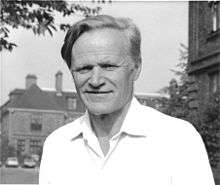Jay Appleton
Jay Appleton (1919 – 27 April 2015) was a British geographer who proposed 'habitat theory' and advanced the notion of 'prospect-refuge'.

Biography
Jay was born in Yorkshire in December 1919. He moved to Stibbard, near Fakenham in Norfolk, at the age of eighteen months. In 1940, he moved south to Diss, but ten years later a university appointment took him back to Yorkshire, and he lived in Cottingham until his death.[1]
Academic career
Appleton was an alumnus of the University of Oxford and the University of Durham where he attended King's College, which is now Newcastle University. He retired in 1985 as an Emeritus Professor of Geography at Hull University.
He was a Human Geographer with a special interest in transport and in 1962 he published "The Geography of Communications in Great Britain".
In 1970, he wrote a report for the Countryside Commission on 'Disused railways in the countryside of England and Wales'.[2]
In 1975, Appleton published The Experience of Landscape, in which he proposed the prospect-refuge theory of human aesthetics. The theory states that taste in art is 'an acquired preference for particular methods of satisfying inborn desires.' The two desires are for opportunity (prospect) and safety (refuge). Tracing these two desires gives us a means of understanding successful and enduring aesthetics, and the ability to predict the same.[3][4]
Other work
During the early 1950s, he began writing Norfolk dialect stories and reading them from Birmingham on the Midland Region Programme of the BBC. More stories were specially written to mark the opening of the BBC studios at St Catherine’s Close in Norwich in 1958.[5]
He is also a published poet.[6]
References
- http://www.family-announcements.co.uk/hull/Search?trm=appleton&cat=414&StartDate=10%2F05%2F2015&EndDate=17%2F05%2F2015&PageNumber=1&Letter=&Sort=
- Disused railways in the countryside of England and Wales. 1970. ISBN 0-11-700489-8. Archived from the original on 2012-03-13. Retrieved 2010-12-14.
- Prospect-Refuge Theory - Notes on Jay Appleton, The Experience of Landscape (London: John Wiley, 1975) and "Tintern Abbey" Archived 2010-01-27 at the Wayback Machine
- Prospect-refuge theory
- CDs AND DVDs OF LOCAL INTEREST (Friends of Norfolk Dialect or F.O.N.D.) - STORIES FROM EAST ANGLIA: Read by David Woodward Archived 2010-08-27 at the Wayback Machine
- The Poetry of Habitat, from Amazon.com